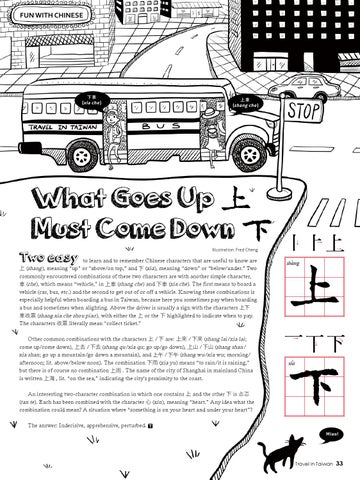FUN WITH CHINESE
下車 (xia che )
Two easy
上車 (shang che )
Illustration: Fred Cheng
to learn and to remember Chinese characters that are useful to know are 上 (shang ), meaning “up” or “above/on top,” and 下 (xia ), meaning “down” or “below/under.” Two commonly encountered combinations of these two characters are with another simple character, 車 (che ), which means “vehicle,” in 上車 (shang che ) and 下車 (xia che ). The first means to board a vehicle (car, bus, etc.) and the second to get out of or off a vehicle. Knowing these combinations is especially helpful when boarding a bus in Taiwan, because here you sometimes pay when boarding a bus and sometimes when alighting. Above the driver is usually a sign with the characters 上下 車收票 (shang xia che shou piao ), with either the 上 or the 下 highlighted to indicate when to pay. The characters 收票 literally mean “collect ticket.” Other common combinations with the characters 上 /下 are: 上來 /下來 (shang lai /xia lai ; come up/come down), 上去 /下去 (shang qu /xia qu ; go up/go down), 上山 /下山 (shang shan / xia shan ; go up a mountain/go down a mountain), and 上午 /下午 (shang wu /xia wu ; morning/ afternoon; lit. above/below noon). The combination 下雨 (xia yu ) means “to rain/it is raining,” but there is of course no combination 上雨 . The name of the city of Shanghai in mainland China is written 上海 , lit. “on the sea,” indicating the city’s proximity to the coast.
shang
xia
An interesting two-character combination in which one contains 上 and the other 下 is 忐忑 (tan te ). Each has been combined with the character 心 (xin ), meaning “heart.” Any idea what the combination could mean? A situation where “something is on your heart and under your heart”? The answer: Indecisive, apprehensive, perturbed. Miao!
Travel in Taiwan
33
